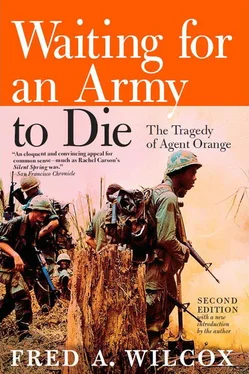Outside it is raining, and the sky has turned the color of a well-ripened plum. Dr. McNulty appears tired, his cough has gotten worse, and the frequency with which he glances at his watch leads me to conclude the interview has gone on long enough. As we shake hands and prepare to leave his office I ask if he would be willing to say that 2,4,5-T should be taken off the market altogether.
“Well,” he replies, “it’s toxic enough that common sense would say the less the better. As far as exposure to dioxin can be avoided, it should be. And I’ll broaden that to say to the class of compounds which all appear to act alike, and that includes the dioxins and the polychlorinated dibenzofurans which are present in pentachlorophenol. [22] Used extensively as a wood preservative.
It’s a much bigger source of dioxin here in Oregon than 2,4,5-T. I’m willing to say what my data is to anybody at any time, provided it has passed the gauntlet and has been accepted—that is, published—by my peers. That’s no problem. I’ll do that for anybody. And if I thought there was a social danger from it, then I would feel a personal obligation to speak out. But I can’t do that just because I know dioxin is toxic and I treat it with extreme caution around here. I can’t leap to a conclusion that I feel is unwarranted on a scientific basis, that it all ought to be stopped. That’s always subject to revision, the way science is. There may be something next year or next month that will change my mind completely on that.”
10. The Vietnamization of America
During the height of the war in Vietnam, television crews, newspaper reporters, and freelance writers followed American and Vietnamese troops into jungles, through swamps, and up mountains. Between toothpaste and shampoo commercials, Americans could watch helicopters strafe “enemy strongholds,” see young Marines returning from an ambush or firefight, and watch the wounded being evacuated or the enemy dead counted following a battle. News coverage of the Vietnam War was so extensive, in fact, that some cynics began referring to the war as a “media event.”
But what Americans did not see during the late sixties or throughout the seventies was the war being waged on their own environment, sometimes right in their own backyards. There were no crews from CBS to witness the Forest Service’s spraying of Bob McKusick’s homestead near Globe, Arizona, in 1968: nor were reporters on hand to observe Boston Edison’s spraying of herbicides near a heavily populated suburb south of Boston in August 1979. When the Long Island Rail Road, without notifying the residents along its rights-of-way, doused homeowners’ gardens and children with toxic herbicides, it didn’t even make the local news. Like the troops in Vietnam, those who lived near national forests, power-line and railroad rights-of-way, or privately owned tree farms had been told—if they were told anything—not to worry; herbicides were harmless.
From 1965 until 1970, when the spraying of Agent Orange was suspended in Vietnam, the US military covered approximately five million acres of Vietnam with herbicides. During those same years, ranchers, farmers, and the Forest Service sprayed 4.1 million acres of the American countryside annually with 2,4,5-T. The Forest Service alone sprayed more than 430,000 acres of national forest every year with 2,4,5-T in an attempt to kill broadleaved plants that might block sunlight from pine and other coniferous saplings. Ranchers used 2,4,5-T to destroy anything that might interfere with livestock grazing, while rice growers sprayed it on about one hundred thousand acres, primarily in Arkansas and Mississippi, to kill parasite weeds like arrowhead, gooseweed, and ducksalad. In 1970, the USDA announced a set of limited restrictions on the use of 2,4,5-T; however, although the ban affected only about 20 percent of all 2,4,5-T used in the United States, Dow Chemical went to court, obtaining an injunction to prevent the Environmental Protection Agency from further regulations until more testing was done. [23] See appendix for a history of 2,4,5-T, 183–185.
Until 1979, when the EPA’s temporary and limited suspension order (which excluded rangelands and rice plantations) was issued, 2,4,5-T had been the most widely used herbicide in the country.
When the National Forest Service first sprayed Bob McKusick’s land, he had no idea that herbicides could be harmful: “The first time was in 1968. The kids were little, and we were out on the clay deposit in Kellner Canyon with two dogs, just standing there on my properly. A helicopter came across—and we’re in plain sight—and we tried to wave it off but the spray drifted down on top of us. I had no reason to believe it was harmful because the Forest Service said it was completely harmless to birds and animals and humans and it just worked on brush. But it caused a rash, and my dog, Coyote, got pneumonia and almost died. A few months later he did die. I notified the Forest Service that we’d been sprayed, but I didn’t know the stuff was bad.” 1
One year later a forest ranger phoned McKusick, who at the time was a professional potter and was fortunate enough to have found a piece of land that included clay deposits, telling him to put pie tins at each corner of his clay deposits to mark the area so it would not be sprayed. But, says McKusick, “they sprayed my clay deposit too.” All of the complaining neighbors were sprayed, including a woman named Billy Shoecraft, who compiled more than a hundred files on chemical poisons before she died of cancer. For three consecutive days the Forest Service sprayed, and, explains McKusick, “We all got bleeding ears; in fact we had bleeding from all body orifices. There’s this disease called IHS—internal hemorrhaging syndrome. In Vietnam 1,300 war dogs got it and the government said it wasn’t because they were spraying with Agent Orange. The dogs got a virus, they said, and had to be destroyed. Well, after the 1969 spraying, we had IHS and I can’t tell you how many horses and cows had it.”
Animals in the canyon began dying, giving birth to deformed offspring, lying paralyzed on the ground. Some even forgot how to breed. Before the spraying, McKusick recalls, there were no problems, no deformities or miscarriages. But in 1969, “60 to 70 percent of our goats were born deformed, and we’ve had heavy deformities ever since.”
McKusick, who has had a series of heart attacks during the fourteen years since the spraying, adds, “I can’t prove any of this was caused by the spray, but all I can say is that before the spray I was healthy as a horse. The doctor told me I would never have heart trouble. And our family did not have a history of illness…”
The McKusicks and other families living in the spray zone attempted to find help in their struggle to get the Forest Service to stop the spraying, but to no avail. “We went to everyone we could think of and nobody would help us. We went to Senator Barry Goldwater and he couldn’t be bothered… We asked Governor Jack Williams for help and he laughed. Representative Sam Steiger was the only exception. He tried to help, but he simply didn’t have the weight to stop it…
“When they first sprayed, the Forest Service said the stuff would disappear in twenty-four hours. Then they changed their story and said it would be gone in three days, and then in thirty days… In [over fourteen] years, not one family here has dared to use their own well water.”
The McKusicks sued Dow Chemical and, after nearly a decade of legal delays, agreed to settle out of court for an undisclosed sum. But money, says McKusick, can never compensate for so many years of insecurity and hardship. “It’s very easy for somebody who has not had his family and himself sick for twelve years, his animals dying around him, and people laughing at him and criticizing him and never helping to say you should have gone and fought it for another three months and then when you won it and they appealed you could wait another ten or eleven years to get back in court and then they’d appeal it again and you could wait another ten or eleven years—just where in the hell does anybody think we’re going to get the strength to do it?
Читать дальше











